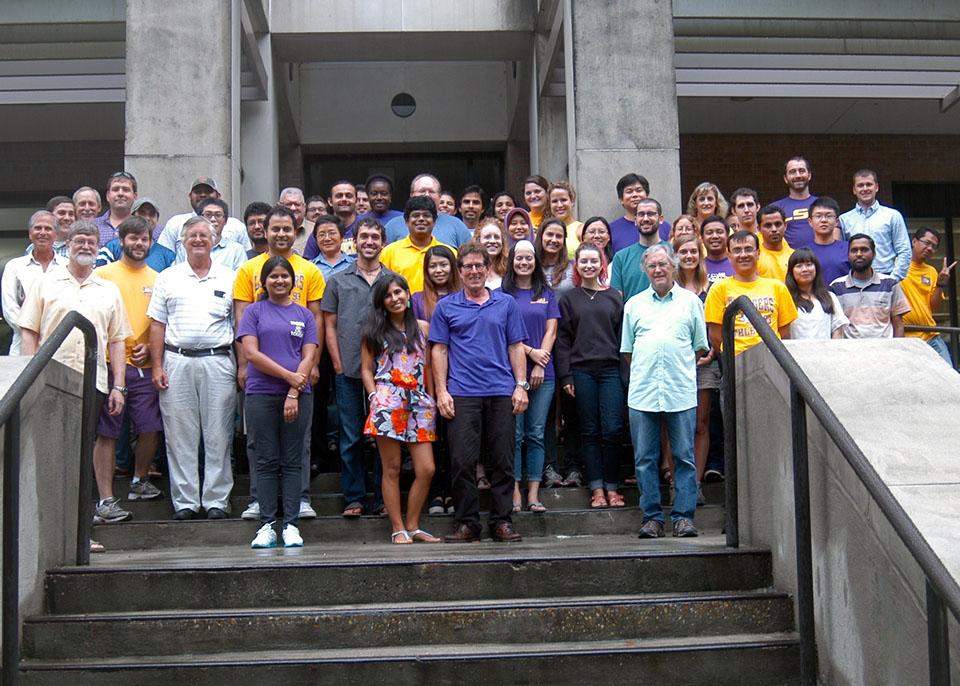DEPARTMENT OF
ENTOMOLOGY
ABOUT THE DEPARTMENT

The Entomology Department at LSU has a long and distinguished tradition of applied and basic research in the field of entomology. Students from around the world have chosen to study entomology at LSU, and continue to win awards annually at national conferences, such as the Entomological Society of America. Our Entomology curriculum includes both traditional entomological courses, as well as new and innovative topics incorporating a deeper understanding of molecular biology, toxicology, resistance management, and epidemiological tools. Lastly, our extension faculty serve stakeholders from around the state in all aspects of entomology. Please watch our youtube video, to find out more about our department.
HISTORY OF THE DEPARTMENT
Insect Studies was the first entomology course offered at LSU in 1886. The Department of Horticulture and Entomology subsequently was established in 1889. The entomology program was moved into the Department of Zoology and Entomology in 1893. At that time the curriculum included Insect Anatomy, Household Insects, Disease Vectors, Sugarcane Insects, Apiculture, Forest Entomology, Photography, Morphology and Taxonomy, and Insect Physiology. In 1949 the Department of Zoology, Physiology and Entomology was formed in the College of Arts and Sciences. Acarology was added to the curriculum.
The present-day Entomology Department was established in 1964. The department was given responsibility for instruction in the College of Agriculture and research in the Louisiana Agriculture Experiment Station (LAES). Dr Dale Newsom was the Department’s first Head (1964-77). Subsequently, Dr. Jerry B. Graves served from 1977 through 1985; followed by Dr. E.A. Heinrichs from 1985 to 1990, and Dr. James R. Fuxa (Interim) from 1990 to 1991. Dr. Frank S. Guillot was Head from 1991 to 2001, followed again by Dr. James R. Fuxa (Interim) from 2001 to 2003. Dr. Timothy D. Schowalter became head in 2003.
In July 2002, Extension Entomology, under the Louisiana Cooperative Extension Service (LCES), was merged with the academic unit, bringing all three missions (instruction, research and extension) of the land grant institution together in the department. A departmental retreat was held in fall, 2003 to review and revise vision, mission and strategic goals to be more representative of the combined departmental programs, to identify priorities for future staffing, and to identify priorities for other departmental needs.
Departmental faculty have provided leadership to a number of developing subdisciplines of Entomology. Pesticide resistance in the boll weevil and horn fly and protection of plants from herbivores by endophytic fungi were first identified by departmental researchers. The department also was among the first to initiate programs in resistance management, forensic entomology, ecosystem management, and urban entomology. Following Hurricanes Katrina and Rita in 2005, departmental faculty provided early surveillance to mosquito and nuisance fly control programs, recommendated quarantine of organic debris for containment of Formosan subterranean termites, identified potential role of Formosan subterranean termites in levee failure, organized the on-campus pet shelter for evacuated pets, organized fire ant suppression in surviving refuge areas and arranged for distribution of fire ant baits to returning evacuees, and evaluated flood effects on termites and fire ants. The department continues to provide strong leadership to the state and nation in the areas of integrated pest management, urban entomology, medical and veterinary entomology, systematics, and ecology.
State support for the department is approximately 60% from LAES, 20% from LCES, and 20% from LSU College of Agriculture. In addition, the department acquires $2-4 million annually in external support from state, federal, commodity, private industry and other sources. Much of this external funding provides support for graduate assistantships and research opportunities for undergraduates.
INSECT MUSEUM
The Louisiana State Arthropod Museum (LSAM) is housed on the 5th floor of the Life Sciences Building on the main campus of LSU. It is part of the Department of Entomology and is a component collection of the Louisiana Museum of Natural History. The LSAM contains approximately 1,000,000 specimens of insects and related arthropods. This includes 900,000 pinned, 18,000 fluid-preserved, and 30,000 slide-mounted specimens. Uncurated specimens in various stages of processing vary through time from 50,000 to 100,000. The LSAM is the principal repository for insects and related arthropods in Louisiana. Significant strengths of the collection include Coleoptera (51%) and Hemiptera (28%). Lepidoptera (6%), Diptera (6%) and Hymenoptera (4%), and other orders (5%) make up the balance of the collection. The collection contains 747 paratypes, 1 syntype, 1 allotype, and 1 holotype. Primary types described by LSAM researchers are normally deposited in dedicated type repositories (e.g., the U. S. National Museum, Field Museum of Natural History, etc.). The majority of specimens are from southeastern United States, and most of the remainder are from elsewhere in North America, Mexico, Central and South America. Recent expeditions have added specimens, mainly Coleoptera, from Ecuador and New Zealand.
